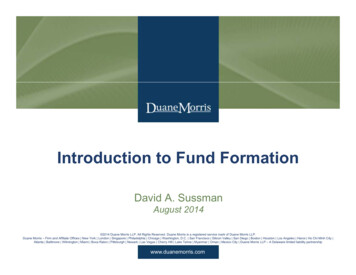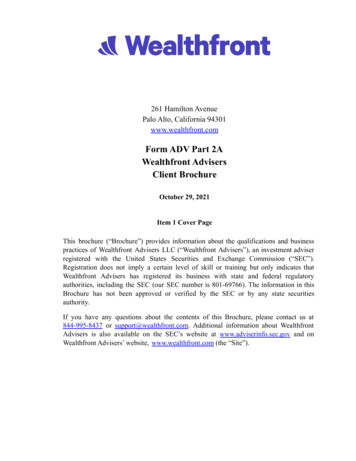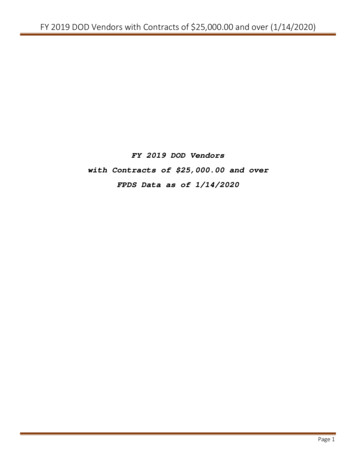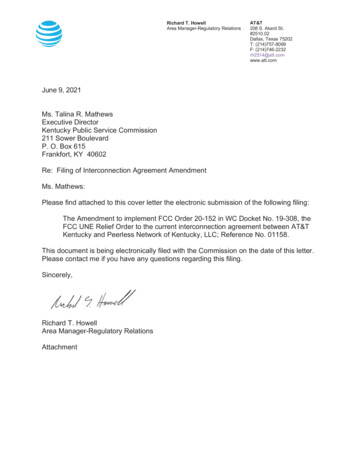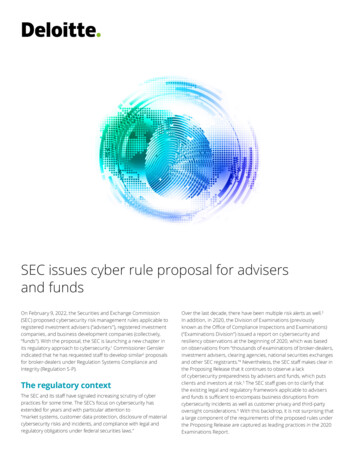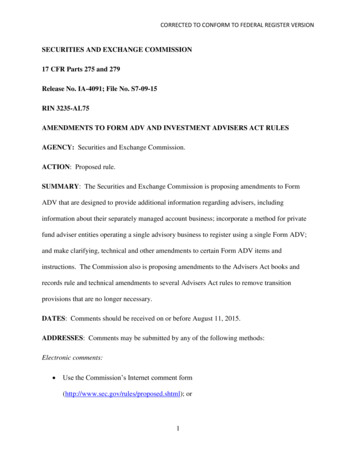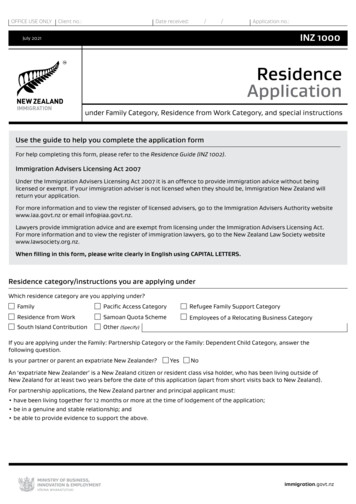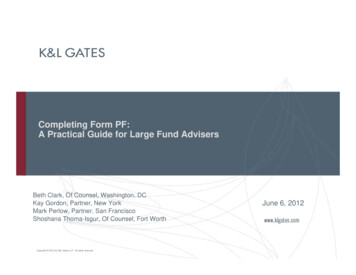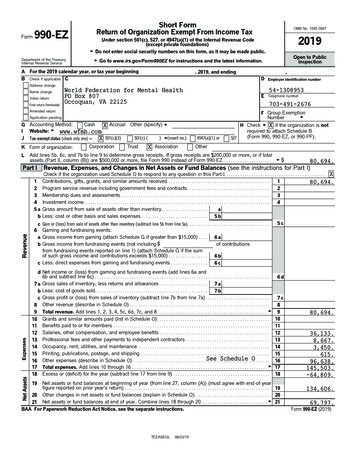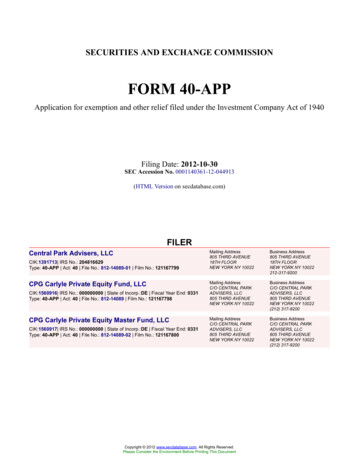
Transcription
SECURITIES AND EXCHANGE COMMISSIONFORM 40-APPApplication for exemption and other relief filed under the Investment Company Act of 1940Filing Date: 2012-10-30SEC Accession No. 0001140361-12-044913(HTML Version on secdatabase.com)FILERCentral Park Advisers, LLCCIK:1391713 IRS No.: 204816629Type: 40-APP Act: 40 File No.: 812-14089-01 Film No.: 121167799CPG Carlyle Private Equity Fund, LLCCIK:1560916 IRS No.: 000000000 State of Incorp.:DE Fiscal Year End: 0331Type: 40-APP Act: 40 File No.: 812-14089 Film No.: 121167798CPG Carlyle Private Equity Master Fund, LLCCIK:1560917 IRS No.: 000000000 State of Incorp.:DE Fiscal Year End: 0331Type: 40-APP Act: 40 File No.: 812-14089-02 Film No.: 121167800Mailing Address805 THIRD AVENUE18TH FLOORNEW YORK NY 10022Business Address805 THIRD AVENUE18TH FLOORNEW YORK NY 10022212-317-9200Mailing AddressC/O CENTRAL PARKADVISERS, LLC805 THIRD AVENUENEW YORK NY 10022Business AddressC/O CENTRAL PARKADVISERS, LLC805 THIRD AVENUENEW YORK NY 10022(212) 317-9200Mailing AddressC/O CENTRAL PARKADVISERS, LLC805 THIRD AVENUENEW YORK NY 10022Business AddressC/O CENTRAL PARKADVISERS, LLC805 THIRD AVENUENEW YORK NY 10022(212) 317-9200Copyright 2012 www.secdatabase.com. All Rights Reserved.Please Consider the Environment Before Printing This Document
UNITED STATES OF AMERICABEFORE THESECURITIES AND EXCHANGE COMMISSIONWASHINGTON, D.C. 20549In the Matter ofCPG Carlyle Private Equity Fund, LLCCPG Carlyle Private Equity Master Fund, LLCCentral Park Advisers, LLCFile No. 812-Copyright 2012 www.secdatabase.com. All Rights Reserved.Please Consider the Environment Before Printing This DocumentAPPLICATION FOR AN ORDERUNDER SECTION 6(c) OF THEINVESTMENT COMPANYACT OF 1940, AS AMENDED(THE "1940 ACT"), FOR ANEXEMPTION FROM SECTIONS18(c) AND 18(i) OF THE 1940ACT, AND UNDERSECTION 17(d) OF THE 1940ACT AND RULE 17d-1THEREUNDER
Written or oral communications regarding this Applicationshould be addressed to:Gary L. Granik, Esq.Stroock & Stroock & Lavan LLP180 Maiden LaneNew York, New York 10038With copies to:Mitchell A. TanzmanCentral Park Group, LLC805 Third Avenue,New York, New York 10022This Application (including Exhibits) consists of 22 pages.The Exhibit Index is on page 19.-2-Copyright 2012 www.secdatabase.com. All Rights Reserved.Please Consider the Environment Before Printing This Document
UNITED STATES OF AMERICABEFORE THESECURITIES AND EXCHANGE COMMISSIONWASHINGTON, D.C. 20549In the Matter ofAPPLICATION FOR AN ORDERUNDER SECTION 6(c) OF THEINVESTMENT COMPANYACT OF 1940, AS AMENDED(THE "1940 ACT"), FOR ANEXEMPTION FROM SECTIONS18(c) AND 18(i) OF THE 1940ACT, AND UNDERSECTION 17(d) OF THE 1940ACT AND RULE 17d-1THEREUNDERCPG Carlyle Private Equity Fund, LLCCPG Carlyle Private Equity Master Fund, LLCCentral Park Advisers, LLCFile No. 812--3-Copyright 2012 www.secdatabase.com. All Rights Reserved.Please Consider the Environment Before Printing This Document
I.THE PROPOSALCPG Carlyle Private Equity Fund, LLC (the "Feeder Fund"), CPG Carlyle Private Equity Master Fund, LLC (the "MasterFund" and together with the Feeder Fund, the "Funds") and Central Park Advisers, LLC (the "Adviser" and collectively with theFeeder Fund and the Master Fund, the "Applicants") hereby submit this application (the "Application") to the Securities and ExchangeCommission (the "Commission") requesting an order under Section 6(c) of the Investment Company Act of 1940, as amended (the"1940 Act"), granting an exemption from Sections 18(c) and 18(i) of the 1940 Act, and under Section 17(d) of the 1940 Act and Rule17d-1 thereunder, to permit the Feeder Fund to offer investors multiple classes of units of beneficial interest ("Units")1 with varyingsales loads and asset-based service and/or distribution fees, as described more fully in this Application. The Applicants request that theorder also apply to any other registered closed-end management investment company that conducts a continuous offering of its Units,existing now or in the future, for which the Adviser or any entity controlling, controlled by, or under common control with the Adviseracts as investment adviser, and which provides periodic liquidity with respect to its Units through tender offers conducted in compliancewith Rule 13e-4 under the Securities Exchange Act of 1934, as amended (the "1934 Act").2 The Feeder Fund and any other investmentcompany relying on this relief will do so in a manner consistent with the terms and conditions of this Application. Applicants representthat any other person presently intending to rely on the order requested in this Application is listed as an Applicant.The Feeder Fund is a newly-formed Delaware limited liability company that is registered under the 1940 Act as a closedend, non-diversified management investment company.3 The Feeder Fund's investment objective is to seek attractive long-term capitalappreciation. In pursuing its investment objective, the Feeder Fund intends to invest substantially all of its assets in the MasterFund, a Delaware limited liability company that also is registered under the 1940 Act as a closed-end, non-diversified managementinvestment company, in reliance on Section 12(d)(1)(E) of the 1940 Act. Through its investment in the Master Fund, which has the sameinvestment objective and substantially the same investment policies as those of the Feeder Fund, the Feeder Fund intends to operate asa "fund of funds" that provides a means for investors to participate in investments in various alternative investment funds (discussedbelow). The Master Fund will not issue multiple classes of its units of beneficial interest and is an Applicant because of the master-feederstructure. The Master Fund intends to invest principally in alternative investment funds with an emphasis on private equity funds (e.g.,buyout, growth and mezzanine). In addition, the Master Fund may, under limited circumstances, invest or trade, directly in securities andfinancial instruments for hedging purposes and/or pursuant to investment advice of discretionary or non-discretionary managers.The Feeder Fund anticipates that the Units will be offered in private placement transactions on a continuous basis at netasset value per unit plus any applicable sales loads, as described in the Feeder Fund's confidential memorandum (the "ConfidentialMemorandum"). As set forth in the Confidential Memorandum, the Feeder Fund currently intends initially to offer continuously a singleclass of Units (the "Class A Units") and, if the requested relief is granted, the Feeder Fund intends to offer continuously an additionalclass of units (the "Class I Units") having its own sales charge and expense structure. Both1As used in this Application, "Units" includes any other equivalent designation of a proportionate ownership interest of the FeederFund (or any other registered closed-end management investment company relying on the requested order).2The terms "control" and "investment adviser" are used as defined in Sections 2(a)(9) and 2(a)(20) of the 1940 Act, respectively.3The Feeder Fund (File No. 811-22763) and Master Fund (File No. 811-22764) filed with the Commission their initial registrationstatement statements on Form N-2 on October 30, 2012.-4-Copyright 2012 www.secdatabase.com. All Rights Reserved.Please Consider the Environment Before Printing This Document
Class A Units and Class I Units will be sold only to persons who are "accredited investors," as defined in Regulation D under theSecurities Act of 1933, as amended (the "Securities Act").The Units will not be offered or traded in a secondary market and will not be listed on any securities exchange or quoted onany quotation medium. Because unitholders will not have the right to require the Feeder Fund to redeem Units, the Feeder Fund mayfrom time to time offer to repurchase Units pursuant to written tenders by unitholders in accordance with Rule 13e-4 under the 1934 Act("Repurchases"), in order to provide a limited degree of liquidity to unitholders.4 Repurchases of Units will be made at such times, insuch amounts and on such terms as may be determined by the Board of Directors (the "Board," and each member thereof, a "Director")of the Feeder Fund in its sole discretion. In determining whether the Feeder Fund should offer to repurchase Units, the Board willconsider a variety of operational, business and economic factors. The Adviser anticipates that, it will recommend to the Board that theFeeder Fund offer to repurchase Units from investors on a quarterly basis, commencing with the first fiscal quarter after two full yearsof fund operations, with such repurchases to occur as of the last day of March, June, September and December (or, if any such date isnot a business day, on the immediately preceding business day). The Feeder Fund generally will not offer to repurchase Units unless theMaster Fund simultaneously conducts a repurchase offer for the Master Fund's units of beneficial interest.As with open-end management investment companies that issue multiple classes of units pursuant to Rule 18f-3 under the1940 Act, the different classes of Units of the Feeder Fund would represent investments in the same portfolio of securities but would besubject to different expenses (such as asset-based service and/or distribution fees). Thus, the net income attributable to, and any dividendspayable on, each class of Units will differ from the other classes from time to time. As a result, the net asset value per Unit of the classesmay differ over time.Under the proposal, each class of Units would be offered at net asset value. The new Unit class—Class I Units—would beoffered at net asset value and may (but would not necessarily) be subject to an annual asset-based service and/or distribution fee. ClassA Units would continue to be offered at net asset value with the front-end sales load and asset-based service and/or distribution feesdisclosed in the Confidential Memorandum, as supplemented or amended from time to time. Each class of Units would comply withthe provisions of Rule 12b-1 under the 1940 Act, or any successor thereto or replacement rules, as if that rule applied to closed-endmanagement investment companies, and with the provisions of Rule 2830(d) of the Conduct Rules of the National Association ofSecurities Dealers, Inc. ("NASD"), as such rule may be amended, or any successor rule thereto ("NASD Conduct Rule 2830")5 as if itapplied to the Feeder Fund. The structure of the proposed classes of Units is described in detail below under Section II.C.If this application for an order is granted, the classes of Units described above may or may not be offered. Additional classesof Units may be added in the future.A number of precedents exist for the implementation of a multiple-class system and the imposition of asset-based service and/or distribution fees for closed-end funds substantially similar to the relief sought by Applicants. See, e.g., BlackRock Preferred PartnersLLC, et al., Investment Company Act Rel. Nos. 30160 (Aug. 2, 2012) (Notice) and 30182 (Aug. 28, 2012) (Order); Versus Capital MultiManager Real Estate Income Fund LLC, et al., Investment Company Act Rel. Nos. 30103 (Jun. 14, 2012)4Similarly, the Master Fund's repurchase offers will be conducted pursuant to Rule 13e-4 under the 1934 Act.5Any references to NASD Conduct Rule 2830 include any successor or replacement rule that may be adopted by the FinancialIndustry Regulatory Authority ("FINRA").-5-Copyright 2012 www.secdatabase.com. All Rights Reserved.Please Consider the Environment Before Printing This Document
(Notice) and 30133 (Jul. 10, 2012) (Order); ASGI Agility Income Fund, et al., Investment Company Act Rel. Nos. 29793 (Sept. 19, 2011)(Notice) and 29837 (Oct. 17, 2011) (Order); Highland Capital Management, L.P., et al., Investment Company Act Rel. Nos. 28888 (Aug.27, 2009) (Notice) and 28908 (Sept. 22, 2009) (Order); Allianz RCM Global Ecotrends Fund, et al., Investment Company Act Rel. Nos.27936 (Aug. 23, 2007) (Notice) and 27971 (Sept. 18, 2007) (Order); Man-Glenwood Lexington, LLC, et al., Investment Company ActRel. Nos. 27263 (Mar. 16, 2006) (Notice) and 27285 (Apr. 11, 2006) (Order); Van Kampen Investment Advisory Corp., et al., InvestmentCompany Act Rel. Nos. 25924 (Feb. 3, 2003) (Notice) and 25951 (Mar. 3, 2003) (Order); Scudder Weisel Capital Entrepreneurs Fundand Scudder Weisel Capital LLC, Investment Company Act Rel. Nos. 24805 (Dec. 27, 2000) (Notice) and 24833 (Jan. 19, 2001) (Order);and Eaton Vance Management, et al., Investment Company Act Rel. Nos. 24648 (Sept. 19, 2000) (Notice) and 24689 (Oct. 16, 2000)(Order).II.STATEMENT OF FACTSA.The ApplicantsEach of the Feeder Fund and the Master Fund is a newly-formed Delaware limited liability company registered under the 1940Act as a closed-end, non-diversified management investment company. Each of the Feeder Fund and the Master Fund was organizedunder the laws of the State of Delaware on October 23, 2012.The Adviser, a wholly-owned subsidiary of Central Park Group, LLC, is a limited liability company organized under the lawsof the State of Delaware and registered with the Commission as an investment adviser under the Investment Advisers Act of 1940, asamended (the "Advisers Act"). The Adviser serves as the investment adviser to the Feeder Fund and the Master Fund.B.Current Structure and CharacteristicsAs noted above, Units will be offered on a continuous basis pursuant to a registration statement under the 1940 Act at their netasset value per Unit plus any applicable sales loads and may be purchased on the first business day of any month, or at such other timesas the Board may determine. The Units will be sold only to persons who are "accredited investors," as defined in Regulation D under theSecurities Act.The Feeder Fund, as a closed-end investment company, does not continuously redeem Units as does an open-end managementinvestment company. Units of the Feeder Fund are not listed on any securities exchange and do not trade on an over-the-countersystem. Furthermore, it is not expected that any secondary market will ever develop for the Units. Thus, in order to provide a limiteddegree of liquidity to unitholders, the Feeder Fund may from time to time offer to repurchase Units at their then current net asset valuepursuant to Rule 13e-4 under the 1934 Act pursuant to written tenders by unitholders. Repurchases will be made at such times, in suchamounts and on such terms as may be determined by the Board, in its sole discretion. The Feeder Fund currently offers a single class ofUnits—Class A Units—that is subject to a maximum sales load of up to 3.50% and to a distribution and service fee charged at the annualrate of 0.60%.66Units are subject to an early withdrawal fee at a rate of 2.00% of the aggregate net asset value of investors' Units repurchasedby the Fund (the "Early Withdrawal Fee") with respect to any repurchase of Units from an investor at any time prior to the dayimmediately preceding the one-year anniversary of the investor's purchase of the Units. The Early Withdrawal Fee charged by theFund is not the same as a contingent deferred sales charge ("CDSC") assessed by an open-end fund pursuant to Rule 6c-10 underthe 1940 Act, as CDSCs are distribution-related charges payable to a distributor, whereas the Early Withdrawal Fee is payable to theFund to compensate long-term unitholders for the expenses related to shorter-term investors, in light of the Fund's-6-Copyright 2012 www.secdatabase.com. All Rights Reserved.Please Consider the Environment Before Printing This Document
C.Proposed Class Structure and CharacteristicsThe Feeder Fund proposes to engage in a continuous offering of Units in the manner described below. The Feeder Fundproposes to offer multiple classes of Units, such as Class A Units and Class I Units, described below, or any other classes. Additionalclasses may permit an investor to choose the method of purchasing Units that the investor deems most beneficial, based on factorsapplicable to the investor, such as the amount of the purchase or the length of time the investor expects to hold the Units. In the future,the Feeder Fund's Board of Directors could adopt this or another sales charge structure.Class A Units would be subject to: (1) a maximum sales load of up to 3.50%; (2) minimum initial investment requirementsof 50,000, and minimum subsequent investment requirements of 10,000; (3) an annual asset-based service and/or distribution fee; and(4) an Early Withdrawal Fee, in each case as set forth in the Confidential Memorandum, as amended or supplemented from time totime. Class A Units will be sold only to persons who are "accredited investors," as defined in Regulation D under the Securities Act.Class I Units would be offered at net asset value and may be subject to an annual asset-based service and/or distribution fee;these charges would differ in some respect from those applicable to Class A Units. The Early Withdrawal Fee will equally apply to ClassI Units and to all classes of Units of the Feeder Fund, consistent with Section 18 of the 1940 Act and Rule 18f-3 thereunder.Actual fees approved and adopted may vary, but a class of Units could not have annual asset-based service and/or distributionfees in excess of the limits established by NASD Conduct Rule 2830.The Feeder Fund has adopted a distribution and service plan in voluntary compliance with Rules 12b-1 and 17d-3 underthe 1940 Act, as if those rules applied to closed-end management investment companies (a "Distribution and Service Plan"). TheFeeder Fund's existing Distribution and Service Plan for Class A Units has been adopted in a manner consistent with Rule 12b-1. TheDistribution and Service Plan was approved by the Feeder Fund's sole Director, and the Distribution and Service Plan will, prior to theissuance of Units of the Feeder Fund, have been approved by a majority of the Directors who are not "interested persons" of the FeederFund (within the meaning of Section 2(a)(19) of the 1940 Act), and who have no direct or indirect financial interest in the operation of theDistribution and Service Plan or in any agreements related to the Distribution and Service Plan, as provided for in Rule 12b-1. Pursuantto its Distribution and Service Plan, the Feeder Fund will pay the broker or dealer appointed by the Feeder Fund to act as distributorof its Units (the "Distributor") an ongoing distribution and service fee (the "Distribution and Service Fee") at an annualized rateof 0.60% of the average net assets attributable to Class A Units. This Distribution and Service Fee consists of compensation for thesale and marketing of Class A Units and for personal services provided to unitholders and/or the maintenance of unitholders accounts(e.g., personal services including, among others, responding to unitholders inquiries and providing information on their investmentsin the Feeder Fund). Applicants represent that these asset-based Distribution and Service fees comply with the provisions of NASDConduct Rule 2830. Applicants represent that the Feeder Fund will comply with Rule 12b-1 under the 1940 Act as if it were an open-endmanagement investment company.All Distribution and Service Fees with respect to any Class I Units would be paid pursuant to a Distribution and Service Planadopted by the Feeder Fund with respect to the applicable class. Under the existing and any future Distribution and Service Plan, theFeeder Fund, either directly or through thegenerally longer-term investment horizons and investment operations. Although the Fund does not currently intend toimpose CDSCs, it would only do so pursuant to Rule 6c-10 under the 1940 Act. CDSCs may be necessary for the Distributor torecover distribution costs.-7-Copyright 2012 www.secdatabase.com. All Rights Reserved.Please Consider the Environment Before Printing This Document
Distributor, would compensate brokers, dealers, or other financial intermediaries for activities primarily intended to result in the sale ofUnits and for personal services provided to unitholders and/or the maintenance of unitholders accounts. Applicants represent that theseasset-based distribution and service fees will comply with the provisions of NASD Conduct Rule 2830. The Feeder Fund does notintend to offer any exchange privilege or conversion feature, but any such privilege or feature introduced in the future will comply withRule 11a-1, Rule 11a-3, and Rule 18f-3 as if the Feeder Fund were an open-end investment company.Although the Feeder Fund does not intend to do so, the Feeder Fund may waive the Early Withdrawal Fee for certain unitholdersor transactions as established from time to time, in circumstances where the Board determines that doing so is in the best interests of theFeeder Fund. With respect to any waiver of, scheduled variation in, or elimination of the Early Withdrawal Fee, the Feeder Fund willcomply with Rule 22d-1 under the 1940 Act as if the Early Withdrawal Fee were a CDSC and as if the Feeder Fund were an open-endinvestment company and the Feeder Fund's waiver of, scheduled variation in, or elimination of, the Early Withdrawal Fee will applyuniformly to all unitholders of the Feeder Fund regardless of class.All expenses incurred by the Feeder Fund will be allocated among its various classes of Units based on the respective net assetsof the Feeder Fund attributable to each such class, except that the net asset value and expenses of each class will reflect the expensesassociated with the Distribution and Service Plan of that class (if any), unitholder servicing fees attributable to a particular class (includingtransfer agency fees, if any), and any other incremental expenses of that class.In addition to distribution and/or service fees, each class of Units of the Feeder Fund may, by action of the Feeder Fund's Boardor its delegate, also pay a different amount of the following expenses:(1)administrative and/or accounting or similar fees (each as described in the Feeder Fund's Confidential Memorandum,as amended or supplemented from time to time);(2)legal, printing and postage expenses related to preparing and distributing to current unitholders of a specific classmaterials such as unitholders reports, Offering Memoranda, and proxies;(3)Blue Sky fees incurred by a specific class;(4)Commission registration fees incurred by a specific class;(5)expenses of administrative personnel and services required to support the unitholders of a specific class;(6)Directors' fees incurred as a result of issues relating to a specific class;(7)Auditors' fees, litigation expenses, and other legal fees and expenses relating to a specific class;(8)incremental transfer agent fees and unitholder servicing expenses identified as being attributable to a specific class;(9)account expenses relating solely to a specific class;-8-Copyright 2012 www.secdatabase.com. All Rights Reserved.Please Consider the Environment Before Printing This Document
(10)expenses incurred in connection with any unitholders meetings as a result of issues relating to a specific class; and(11)any such other expenses (not including advisory or custodial fees or other expenses related to the management of theFeeder Fund's assets) actually incurred in a different amount by a class or related to a class' receipt of services of adifferent kind or to a different degree than another class.Any income, gain, loss and expenses of the Feeder Fund not allocated to specific classes as described above will be charged tothe Feeder Fund and allocated to each class of the Feeder Fund in a manner consistent with Rule 18f-3(c)(1) under the 1940 Act.From time to time, the Board of the Feeder Fund may create and offer additional classes of Units, or may vary the characteristicsdescribed above of Class A Units and Class I Units, including without limitation, in the following respects: (1) the amount of feespermitted by a Distribution and Service Plan as to such class; (2) voting rights with respect to a Distribution and Service Plan as to suchclass; (3) different class designations; (4) the impact of any class expenses directly attributable to a particular class of Units allocated ona class basis as described in this Application; (5) differences in any dividends and net asset values per Unit resulting from differences infees under a Distribution and Service Plan or in class expenses; (6) any sales load structure; and (7) any conversion features, as permittedunder the 1940 Act. The Feeder Fund will comply with the provisions of Rule 18f-3 under the 1940 Act, as if it were an open-endmanagement investment company. The Feeder Fund's Repurchases will be made to all of its classes of Units at the same time, in thesame proportional amounts and on the same terms, except for differences in net asset values per Unit resulting from differences in feesunder a Distribution and Service Plan and/or service plan or in class expenses.Because of the different distribution fees, unitholder services fees, and any other class expenses that may be attributable to thedifferent classes, the net income attributable to, and any dividends payable on, each class of Units may differ from each other from time totime. As a result, the net asset value per Unit of the classes may differ over time. Expenses of the Feeder Fund, allocated to a particularclass of the Feeder Fund's Units will be borne on a pro rata basis by each outstanding Unit of that class.III.EXEMPTIONS REQUESTEDA.The Multiple Class SystemApplicants request exemptive relief to the extent that the proposed issuance and sale of multiple classes of Units of the FeederFund may be deemed: (1) to result in the issuance of a "senior security" within the meaning of Section 18(g) of the 1940 Act and thus beprohibited by Section 18(c); and (2) to violate the equal voting provisions of Section 18(i) of the 1940 Act.B.Asset-Based Service and/or Distribution FeesApplicants request an order pursuant to Section 17(d) of the 1940 Act and Rule 17d-1 thereunder to the extent necessary for theFeeder Fund to pay asset-based service and/or distribution fees.IV.COMMISSION AUTHORITYPursuant to Section 6(c) of the 1940 Act, the Commission may, by order on application, conditionally or unconditionallyexempt any person, security, or transaction, or any class or classes of persons, securities, or transactions, from any provision or provisionsof the 1940 Act or from any rule or regulation under the 1940 Act, if and to the extent that the exemption is necessary or appropriate inthe-9-Copyright 2012 www.secdatabase.com. All Rights Reserved.Please Consider the Environment Before Printing This Document
public interest and consistent with the protection of investors and the purposes fairly intended by the policy and provisions of the 1940Act.Pursuant to Section 17(d) of the 1940 Act and Rule 17d-1 thereunder, the Commission may issue an order permitting anaffiliated person of or a principal underwriter for a registered investment company, or any affiliated person of such a person or principalunderwriter, acting as principal, to participate in or effect any transaction in connection with any joint enterprise or other joint arrangementor profit sharing plan in which the investment company, or a company controlled by such registered company, participates. In reviewingapplications submitted under Section 17(d) and Rule 17d-1, the Commission considers whether the participation of the investmentcompany in a joint enterprise, joint arrangement or profit sharing plan is consistent with the provisions, policies, and purposes of the 1940Act, and the extent to which the participation is on a basis different from or less advantageous than that of other participants.V.DISCUSSIONA.BackgroundIn its 1992 study entitled Protecting Investors: A Half Century of Investment Company Regulation ("Protecting Investors"), theCommission's Division of Investment Management recognized that the 1940 Act imposes a rigid classification system that dictates manyimportant regulatory consequences.7 For example, the characterization of a management company as "open-end" or "closed-end" has,historically, been crucial to the determination of the degree of liquidity the fund's unitholders will have, and thus the liquidity required ofthe fund's investments.Historically, except as noted below, there has been no middle ground between the two extremes of the open-end and theclosed-end forms. Open-end funds have offered complete liquidity to their unitholders and thus required a high degree of liquidity ofthe underlying investment portfolio, while closed-end funds have been subject to requirements that in fact restrict the liquidity theyare permitted to offer their investors. Under this bipolar system of regulation, neither form has provided the best vehicle for offeringportfolios that have significant, but not complete, liquidity. In Protecting Investors, the staff of the Commission determined that, giventhe changes in the securities market since 1940—in particular the emergence of semi-liquid investment opportunities—it was appropriateto re-examine the classification system and its regulatory requirements and that it would be appropriate to provide the opportunity forinvestment companies to "chart new territory" between the two extremes of the open-end and the closed-end forms, consistent withinvestor protection.8One exception to the open-end/closed-end dichotomy cited in Protecting Investors has been the so-called "prime ratefund." Many of these funds, first introduced in 1988, invest in adjustable rate senior loans and provide unitholders liquidity throughquarterly repurchases ("Closed-End Tender Offer Funds").Shortly after Protecting Investors was published, the Commission proposed Rule 23c-3 under the 1940 Act, which providedflexibility to increase unitholders liquidity through periodic tender offers under si
CPG Carlyle Private Equity Fund, LLC INVESTMENT COMPANY CPG Carlyle Private Equity Master Fund, LLC ACT OF 1940, AS AMENDED Central Park Advisers, LLC (THE "1940 ACT"), FOR AN EXEMPTION FROM SECTIONS 18(c) AND 18(i) OF THE 1940 ACT, AND UNDER SECTION 17(d) OF THE 1940 ACT AND RULE 17d-1 THEREUNDER File No. 812-_-3-
